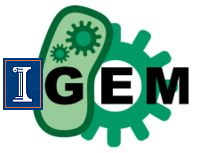Team:Illinois/Project
From 2008.igem.org
| Line 134: | Line 134: | ||
</html> | </html> | ||
<br> | <br> | ||
| - | |||
| - | |||
| - | |||
| - | |||
| - | |||
== '''Project Abstract''' == | == '''Project Abstract''' == | ||
| Line 145: | Line 140: | ||
The unifying motivation behind our research this year is the creation of novel diagnostic tools for medicine. To this end, we are conducting three parallel research projects to create cell-based biosensors. We are currently engineering a bimolecular fluorescence system in which two halves of a fluorescent protein, each fused to an antigenic epitope, will bind to the two sites on an antibody in human serum to cause a detectable fluorescent signal when antibodies against this specific antigen are present. These proteins can be produced in bulk through a bacterial expression system. We are also pursuing similar diagnostic objectives using a eukaryotic system; we are designing strains of yeast able to respond specifically to immunogenic epitopes or antibodies, and activate a fluorometric or enzymatic response accordingly. We are fusing antibodies against immunological targets to cell surface receptors of transcriptional signaling pathways, which would become activated only in the presence of these pathogens. | The unifying motivation behind our research this year is the creation of novel diagnostic tools for medicine. To this end, we are conducting three parallel research projects to create cell-based biosensors. We are currently engineering a bimolecular fluorescence system in which two halves of a fluorescent protein, each fused to an antigenic epitope, will bind to the two sites on an antibody in human serum to cause a detectable fluorescent signal when antibodies against this specific antigen are present. These proteins can be produced in bulk through a bacterial expression system. We are also pursuing similar diagnostic objectives using a eukaryotic system; we are designing strains of yeast able to respond specifically to immunogenic epitopes or antibodies, and activate a fluorometric or enzymatic response accordingly. We are fusing antibodies against immunological targets to cell surface receptors of transcriptional signaling pathways, which would become activated only in the presence of these pathogens. | ||
| - | + | [[Image:Example.png|200px|right]] | |
| - | + | ||
| - | |||
| - | |||
| - | |||
== Subprojects == | == Subprojects == | ||
| - | |||
| - | |||
| - | |||
| - | |||
=== [[Team:Illinois/Antibody_GPCR_Fusion|Antibody GPCR Fusion]] === | === [[Team:Illinois/Antibody_GPCR_Fusion|Antibody GPCR Fusion]] === | ||
| Line 163: | Line 150: | ||
=== [[Team:Illinois/Antibody_RTK_Fusion|Antibody Receptor Tyrosine Kinase Fusion]] === | === [[Team:Illinois/Antibody_RTK_Fusion|Antibody Receptor Tyrosine Kinase Fusion]] === | ||
| - | This project will attempt to detect a pathogen by | + | This project will attempt to detect a pathogen by fusing an antibody to a receptor tyrosine kinase. |
=== [[Team:Illinois/Bimolecular_Fluorescence_Biosensor|Bimolecular Fluorescence Biosensor]] === | === [[Team:Illinois/Bimolecular_Fluorescence_Biosensor|Bimolecular Fluorescence Biosensor]] === | ||
A soluble biosensor that activates a fluorescent protein upon binding a specific biomolecule | A soluble biosensor that activates a fluorescent protein upon binding a specific biomolecule | ||
| - | |||
| - | |||
{{bottom_template}} | {{bottom_template}} | ||
Revision as of 04:26, 3 October 2008
| Home | Team | Notebook | Research Articles | Protocols | Project | Pictures | Parts |
Contents |
Project Abstract
The unifying motivation behind our research this year is the creation of novel diagnostic tools for medicine. To this end, we are conducting three parallel research projects to create cell-based biosensors. We are currently engineering a bimolecular fluorescence system in which two halves of a fluorescent protein, each fused to an antigenic epitope, will bind to the two sites on an antibody in human serum to cause a detectable fluorescent signal when antibodies against this specific antigen are present. These proteins can be produced in bulk through a bacterial expression system. We are also pursuing similar diagnostic objectives using a eukaryotic system; we are designing strains of yeast able to respond specifically to immunogenic epitopes or antibodies, and activate a fluorometric or enzymatic response accordingly. We are fusing antibodies against immunological targets to cell surface receptors of transcriptional signaling pathways, which would become activated only in the presence of these pathogens.
Subprojects
Antibody GPCR Fusion
This team will attempt pathogen detection by fusing the appropriate antibody domain to a GPCR receptor and upon binding of the target protein (i.e. cholera toxin), linking the resulting signal cascade to transcription of a reporter, GFP or LacZ.
Antibody Receptor Tyrosine Kinase Fusion
This project will attempt to detect a pathogen by fusing an antibody to a receptor tyrosine kinase.
Bimolecular Fluorescence Biosensor
A soluble biosensor that activates a fluorescent protein upon binding a specific biomolecule
| Home | Team | Project | Notebook | Research Articles | Parts | Protocols | Pictures |
 "
"
